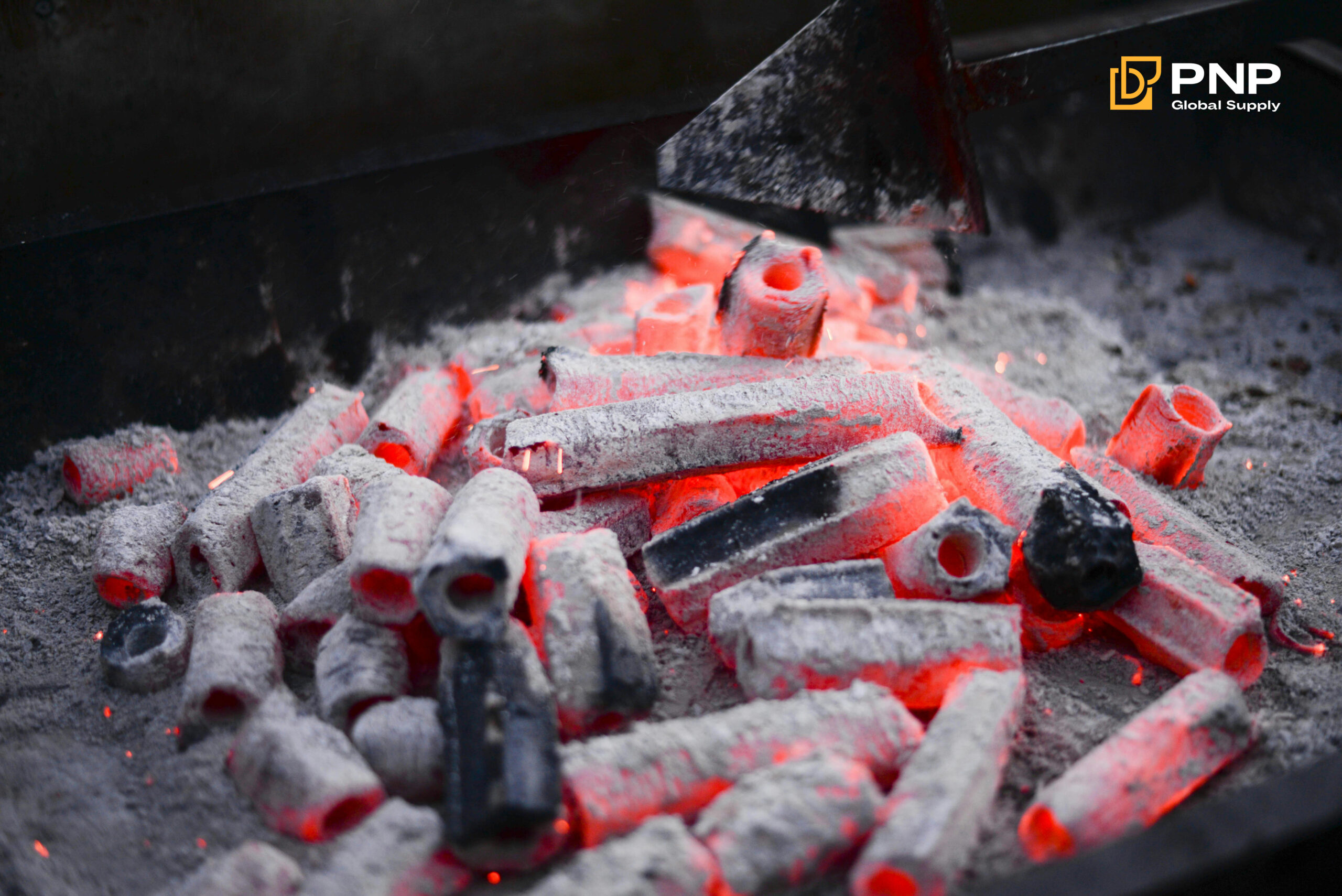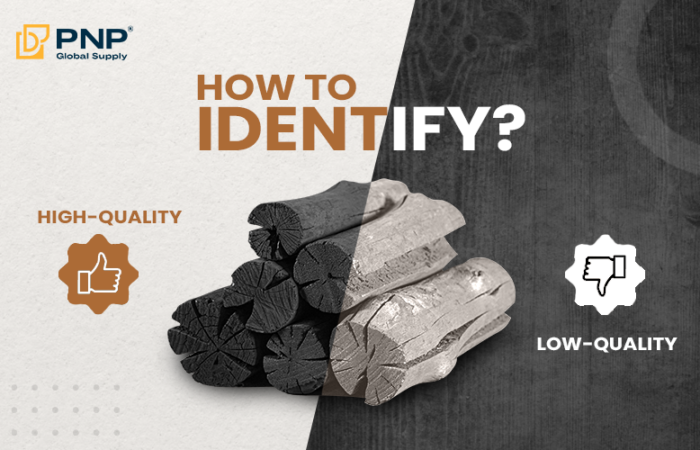Charcoal is the heart of every great BBQ session. It brings high heat, a signature smoky flavor, and that satisfying crackle you just don’t get from gas or electric grills. But one question consistently pops up for both beginners and seasoned grillers: how long does charcoal burn?
Knowing the typical charcoal burn time and learning how to control it can help you manage heat better, save fuel, and make sure your grilled food turns out perfect every time. This article will walk you through burn times for different types of charcoal, what affects those times, and simple ways to make your charcoal burn longer.

How Long Does Charcoal Burn on Average?
Lump charcoal typically burns for 1 to 1.5 hours. Made from natural hardwood pieces without additives, it burns hotter and faster but with less consistency and a shorter charcoal burn time.
Charcoal briquettes, on the other hand, offer a longer and more stable charcoal burning time, often reaching 3 to 3.5 hours. Due to their compressed and uniform shape, they maintain a steady temperature and are a preferred choice for low-and-slow grilling or smoking.
So the type of fuel you choose plays a major role in determining your total burning time of charcoal briquettes or lump variants, which ultimately affects your cooking results.
The Role of Charcoal Burning Temperature
Charcoal burning temperature plays a big part in how fast your charcoal is consumed. High heat is great for searing, but it can cut down burn time significantly
Lump charcoal can reach temperatures up to 700°C. This makes it ideal for high-heat grilling, but it also means the charcoal will burn out quickly if not managed properly
Charcoal briquettes tend to burn at slightly lower temperatures, around 600°C, but they last longer and give off a steadier heat. Managing the airflow and controlling how much oxygen reaches your fire helps regulate this temperature and extend burn time
In general, the higher the temperature, the shorter your charcoal burn time.
What Affects Charcoal Burn Time?
Charcoal burn time depends on more than just the type of fuel. Several other factors can either extend or shorten the burn
Type and Size of Charcoal
Larger chunks of lump charcoal burn slower than smaller ones. Similarly, high-density briquettes will burn longer than low-quality alternatives. Uniformity matters when it comes to burn consistency
Airflow Control
Oxygen fuels fire. If too much air reaches your coals, the temperature spikes and your charcoal burns out quickly. Managing your vents is key. Open vents create high heat for searing, while closed or half-open vents promote slower, controlled burning
Grill Design
Closed-lid grills trap heat and smoke, reducing the need for constant high temperatures. They also limit airflow, extending charcoal burning time. On open grills, oxygen flows freely, often causing the charcoal to burn too fast
Outdoor Conditions
Windy weather increases oxygen flow and accelerates burning. Cold weather requires more fuel to maintain desired temperature, also reducing charcoal burn time
Moisture and Storage
Charcoal that has absorbed moisture doesn’t light well and burns inconsistently. Always store charcoal in a dry, airtight container to protect its quality. Wet charcoal not only burns poorly but may produce excess smoke.

Why Your Charcoal Might Be Burning Too Fast
Charcoal burning too fast is a common issue, especially among beginners. It usually comes down to one or more of the following reasons.
- Vents are wide open, allowing too much oxygen to fuel the fire
- Charcoal pieces are too small or loosely stacked
- The lid of the grill is left open too often
- Poor-quality or over-dried charcoal burns faster than normal
To fix this, monitor your vents closely, stack your charcoal properly, and use a covered grill whenever possible. These small changes can noticeably improve your charcoal burn time.
Tips to Maximize Charcoal Burn Time
Want to make your charcoal last longer? Try these tried-and-true grilling tips
- Use a smart stacking method
Techniques like the snake method or minion method help control how your charcoal burns. Instead of lighting all your coals at once, light one end and let it burn gradually. This technique is especially useful for low and slow cooking
- Adjust your airflow
Don’t leave your vents wide open. Too much oxygen will boost the fire, leading to fast burning. Partially close your vents to slow down the burn without snuffing it out
- Keep the lid closed
Opening the grill lid frequently causes heat loss and forces the fire to work harder to stay hot. This results in charcoal burning faster than necessary
- Avoid stirring the charcoal too often
Every time you stir or shift your charcoal, you introduce fresh oxygen and disturb the burning rhythm. Only adjust the charcoal when absolutely necessary
- Start with enough fuel
One of the biggest mistakes is underestimating how much charcoal you’ll need. Begin with a full basket and add unlit charcoal gradually during longer cooking sessions
Especially for lump charcoal, choose big, dense pieces. They burn slower and offer more consistent heat over time

How to Keep the Heat Going During Long BBQ Sessions
Some grilling sessions, especially for brisket or ribs, can last several hours. To keep your heat steady, you need to plan ahead
Add unlit charcoal pieces gradually to your fire. This helps the new fuel catch from the existing embers without dropping the temperature too low or causing sudden heat spikes
You can also mix in hardwood chunks for additional heat and smoke. These pieces burn longer and provide a flavor boost
Use a grill thermometer to track internal heat and adjust airflow as needed. If temperatures start to drop, open the vents slightly or add more charcoal. If they climb too high, close the vents partially
Using a charcoal basket can help maintain a tight, consistent pile of charcoal. This setup minimizes airflow between pieces, reducing the risk of flare-ups and uneven burning.
At PNP Charcoal, we provide a wide range of high-quality charcoal products suitable for all your grilling needs. Whether you need lump charcoal, briquettes, or specialty hardwood chunks, our products ensure consistent heat and excellent burn time for every BBQ session.
Visit pnpcharcoal to learn more about our charcoal types and find the perfect match for your grilling style.
For more detailed tips on controlling and even extinguishing charcoal safely, check out our full guide here:
Conclusion
So, how long does charcoal burn? It depends on the type and conditions. But burn time isn’t fixed—it’s influenced by temperature, airflow, fuel quality, and your grilling techniques.
If your charcoal is burning too fast, you can take control by adjusting your airflow, managing the lid, stacking charcoal properly, and selecting high-quality fuel. Mastering these elements gives you better heat control, more consistent results, and less fuel waste.
Whether you’re searing steaks or slow-smoking a brisket, optimizing your charcoal burn will make every BBQ session more efficient and enjoyable. Make the most of every flame, because good grilling starts with great fuel control.
________________________________
Contact us for more information
Facebook: PNP Charcoal
Instagram: PNP Charcoal
Email: info@pnpglobalsupply.com




